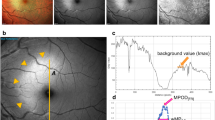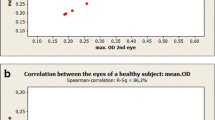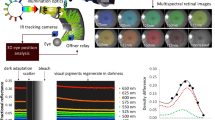Abstract
Background
Measurement of macular pigment (MP) can be performed by analysis of autofluorescence (AF) images. These can be obtained by standard 488-nm argon-imaging alone (one wavelength, 1-Λ) or with additional digital subtraction of a second image at 514 nm (two wavelengths, 2-Λ). The analyses are easy to perform, and we present a comparison of both methods and investigate their reliability and repeatability.
Methods
Inter-individual variability of MP optical density (MPOD) measurements was assessed in single eyes of 120 subjects with a modified Heidelberg retina angiograph (HRA). MPOD values obtained with one (488 nm) Λ (MPOD1Λ) were compared with those obtained with two (488 nm and 514 nm) Λ (MPOD2Λ). To test the repeatability of the two methods, 20 subjects were subjected to five repeated measurements.
Results
Among 120 individuals, mean MPOD1Λ at 0.5° eccentricity was 0.59 (range 0.06–1.32), mean MPOD2Λ was 0.5 (range 0.01–1.21). Apart from this systematic difference, 1-Λ and 2-Λ measurements at 0.5° agreed well across the range of MPOD values (β=0.964, 95% CI 0.891–1.096; R=0.83). At 2° around the fovea, a systematic difference (0.11) was accompanied by declining agreement at higher MPOD values (β=0.669, 95% CI 0.519–0.844; R=0.48). Among 20 subjects with five repeated measurements, the reliability ratio was 0.97 for 1-Λ and 0.94 for 2-Λ at 0.5° and 0.93 and 0.94, respectively, at a distance of 2°.
Conclusions
Both methods showed a high repeatability with little influence of measurement error. They agree well at the fovea centre in terms of ranking individuals according to their MPOD, but provide increasingly deviating results at a distance of 2° around the fovea, probably because the 1-Λ method, in contrast to the 2-Λ method, cannot compensate for disruptive influences and for heterogeneous distributions of the lipofuscin fluorophores. The 1-Λ method can be performed by standard HRA and could therefore be used for screening in multicentre studies, but only approaches the actual amounts of MP. The 2-Λ method remains the more precise method for MPOD measurement in autofluorescence imaging.



Similar content being viewed by others
References
AREDS (2001) A randomized, placebo-controlled, clinical trial of high-dose supplementation with vitamins C and E and beta carotene for age-related cataract and vision loss: AREDS report no. 9. Arch Ophthalmol 119(10):1439–1452
Beatty S, Koh H, Phil M, Henson D, Boulton M (2000) The role of oxidative stress in the pathogenesis of age-related macular degeneration. Surv Ophthalmol 45(2):115–134
Beatty S, Murray IJ, Henson DB, Carden D, Koh H, Boulton ME (2001) Macular pigment and risk for age-related macular degeneration in subjects from a Northern European population. Invest Ophthalmol Vis Sci 42(2):439–446
Berendschot TT, Goldbohm RA, Klopping WA, van de Kraats J, van Norel J, van Norren D (2000) Influence of lutein supplementation on macular pigment, assessed with two objective techniques. Invest Ophthalmol Vis Sci 41(11):3322–3326
Berendschot TT, Willemse-Assink JJ, Bastiaanse M, de Jong PT, van Norren D (2002) Macular pigment and melanin in age-related maculopathy in a general population. Invest Ophthalmol Vis Sci 43(6):1928–1932
Bernstein PS, Zhao DY, Sharifzadeh M, Ermakov IV, Gellermann W (2004) Resonance Raman measurement of macular carotenoids in the living human eye. Arch Biochem Biophys 430(2):163–169
Bernstein PS, Zhao DY, Wintch SW, Ermakov IV, McClane RW, Gellermann W (2002) Resonance Raman measurement of macular carotenoids in normal subjects and in age-related macular degeneration patients. Ophthalmology 109(10):1780–1787
Bone RA, Landrum JT (1984) Macular pigment in Henle fiber membranes: a model for Haidinger’s brushes. Vision Res 24(2):103–108
Bone RA, Landrum JT (2004) Heterochromatic flicker photometry. Arch Biochem Biophys 430(2):137–142
Bone RA, Landrum JT, Cains A (1992) Optical density spectra of the macular pigment in vivo and in vitro. Vision Res 32(1):105–110
Bone RA, Landrum JT, Fernandez L, Tarsis SL (1988) Analysis of the macular pigment by HPLC: retinal distribution and age study. Invest Ophthalmol Vis Sci 29(6):843–849
Bone RA, Landrum JT, Guerra LH, Ruiz CA (2003) Lutein and zeaxanthin dietary supplements raise macular pigment density and serum concentrations of these carotenoids in humans. J Nutr 133(4):992–998
Bone RA, Landrum JT, Mayne ST, Gomez CM, Tibor SE, Twaroska EE (2001) Macular pigment in donor eyes with and without AMD: a case-control study. Invest Ophthalmol Vis Sci 42(1):235–240
Dasch B, Fuhs A, Schmidt J, Behrens T, Meister A, Wellmann J, Fobker M, Pauleikhoff D, Hense HW (2005) Serum levels of macular carotenoids in relation to age-related maculopathy: the Muenster Aging and Retina Study (MARS). Graefe’s Arch Clin Exp Ophthalmol 243(10):1028–1035
Delori FC (2004) Autofluorescence method to measure macular pigment optical densities fluorometry and autofluorescence imaging. Arch Biochem Biophys 430(2):156–162
Delori FC, Dorey CK, Staurenghi G, Arend O, Goger DG, Weiter JJ (1995) In vivo fluorescence of the ocular fundus exhibits retinal pigment epithelium lipofuscin characteristics. Invest Ophthalmol Vis Sci 36(3):718–729
Delori FC, Goger DG, Dorey CK (2001) Age-related accumulation and spatial distribution of lipofuscin in RPE of normal subjects. Invest Ophthalmol Vis Sci 42(8):1855–1866
Delori FC, Goger DG, Hammond BR, Snodderly DM, Burns SA (2001) Macular pigment density measured by autofluorescence spectrometry: comparison with reflectometry and heterochromatic flicker photometry. J Opt Soc Am A Opt Image Sci Vis 18(6):1212–1230
Eldred GE, Katz ML (1988) Fluorophores of the human retinal pigment epithelium: separation and spectral characterization. Exp Eye Res 47(1):71–86
Elsner AE, Burns SA, Beausencourt E, Weiter JJ (1998) Foveal cone photopigment distribution: small alterations associated with macular pigment distribution. Invest Ophthalmol Vis Sci 39(12):2394–2404
Gellermann W, Ermakov IV, Ermakova MR, McClane RW, Zhao DY, Bernstein PS (2002) In vivo resonant Raman measurement of macular carotenoid pigments in the young and the aging human retina. J Opt Soc Am A Opt Image Sci Vis 19(6):1172–1186
Hammond BR Jr, Johnson EJ, Russell RM, Krinsky NI, Yeum KJ, Edwards RB, Snodderly DM (1997) Dietary modification of human macular pigment density. Invest Ophthalmol Vis Sci 38(9):1795–1801
Heidelberg Engineering (2004) Macular pigment optical density measurements. (Technical booklet)
Fendrich T (2005) Personal communication, Heidelberg Engineering
Jahn CW, H, Brinkmann C, Trautmann S, Möβner A, Wolf S (2005) Macular pigment density in age-related maculopathy. Graefe’s Arch Clin Exp Ophthalmol 243:222–227
Liew SH, Gilbert CE, Spector TD, Mellerio J, Marshall J, van Kuijk FJ, Beatty S, Fitzke F, Hammond CJ (2005) Heritability of macular pigment: a twin study. Invest Ophthalmol Vis Sci 46(12):4430–4436
Pauleikhoff D, van Kuijk FJ, Bird AC (2001) Macular pigment and age-related macular degeneration. Ophthalmologe 98(6):511–519
Rapp LM, Maple SS, Choi JH (2000) Lutein and zeaxanthin concentrations in rod outer segment membranes from perifoveal and peripheral human retina. Invest Ophthalmol Vis Sci 41(5):1200–1209
Robson AG MJ, Pauleikhoff D, Morrissey T, Holder GE, Fitzke FW, Bird CA, van Kuijk FJ (2003) Macular pigment density and distribution: comparison of the fundus autofluorescence with minimum motion photometry. Vision Res 43:1765–1775
Seddon JM, Ajani UA, Sperduto RD, Hiller R, Blair N, Burton TC, Farber MD, Gragoudas ES, Haller J, Miller DT et al (1994) Dietary carotenoids, vitamins A, C, and E, and advanced age-related macular degeneration. Eye disease case-control study group. Jama 272(18):1413–1420
Snodderly DM (1995) Evidence for protection against age-related macular degeneration by carotenoids and antioxidant vitamins. Am J Clin Nutr 62(6 Suppl):1448S–1461S
Snodderly DM, Russett MD, Land RI, Krinsky NI (1990) Plasma carotenoids of monkeys (Macaca fascicularis and Saimiri sciureus) fed a nonpurified diet. J Nutr 120(12):1663–1671
Snodderly DM, Shen B, Land RI, Krinsky NI (1997) Dietary manipulation of plasma carotenoid concentrations of squirrel monkeys (Saimiri sciureus). J Nutr 127(1):122–129
Sommerburg OG, Siems WG, Hurst JS, Lewis JW, Kliger DS, van Kuijk FJ (1999) Lutein and zeaxanthin are associated with photoreceptors in the human retina. Curr Eye Res 19(6):491–495
Stockman A, Sharpe LT, Merbs S, Nathans J (2000) Spectral sensitivities of human cone visual pigments determined in vivo and in vitro. Methods Enzymol 316:626–650
Trieschmann M, Spital G, Lommatzsch A, van Kuijk E, Fitzke F, Bird AC, Pauleikhoff D (2003) Macular pigment: quantitative analysis on autofluorescence images. Graefe’s Arch Clin Exp Ophthalmol 241(12):1006–1012
von Ruckmann A, Fitzke FW, Bird AC (1995) Distribution of fundus autofluorescence with a scanning laser ophthalmoscope. Br J Ophthalmol 79(5):407–412
Wooten BR, Hammond BR Jr, Land RI, Snodderly DM (1999) A practical method for measuring macular pigment optical density. Invest Ophthalmol Vis Sci 40(11):2481–2489
Wüstemeyer H JC, Nestler A, Barth T, Wolf S (2002) A new instrument for the quantification of macular pigment density: first results in patients with AMD and healthy subjects. Graefe’s Arch Clin Exp Ophthalmol 240:666–671
Wustemeyer H, Moessner A, Jahn C, Wolf S (2003) Macular pigment density in healthy subjects quantified with a modified confocal scanning laser ophthalmoscope. Graefe’s Arch Clin Exp Ophthalmol 241(8):647–651
Acknowledgement
We are grateful to François Delori for helping us with the theoretical considerations presented in this paper.
Author information
Authors and Affiliations
Corresponding author
Rights and permissions
About this article
Cite this article
Trieschmann, M., Heimes, B., Hense, H.W. et al. Macular pigment optical density measurement in autofluorescence imaging: comparison of one- and two-wavelength methods. Graefe's Arch Clin Exp Ophthalmol 244, 1565–1574 (2006). https://doi.org/10.1007/s00417-006-0289-3
Received:
Revised:
Accepted:
Published:
Issue Date:
DOI: https://doi.org/10.1007/s00417-006-0289-3




